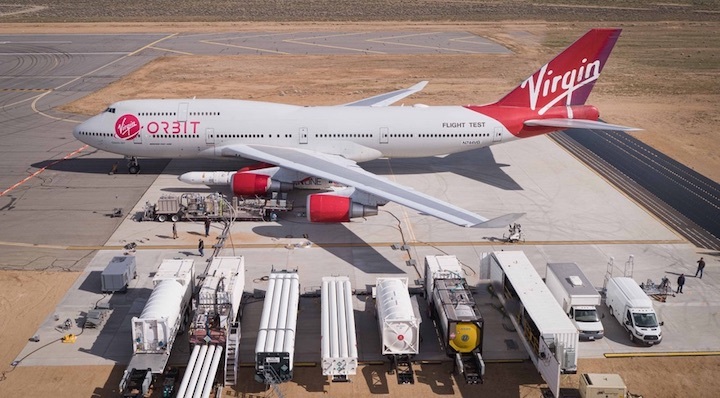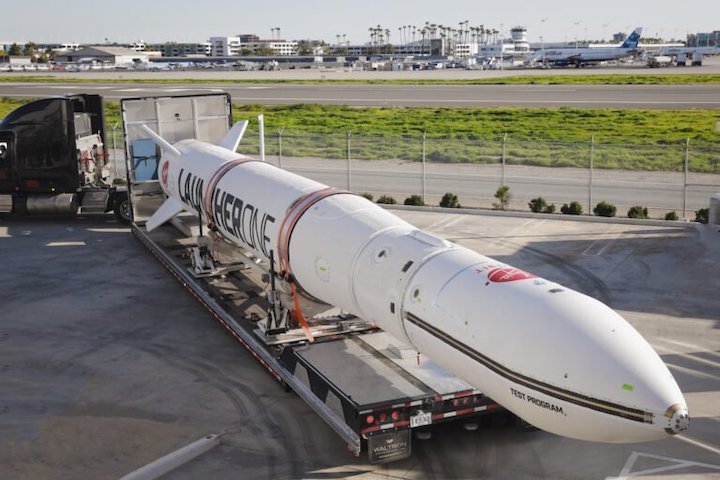6.02.2020

MOUNTAIN VIEW, Calif. — Virgin Orbit says it is weeks away from the first orbital launch of its LauncherOne rocket as the company makes plans to move quickly into operations if that flight is successful.
The company said in a series of tweets Jan. 31 that is in final preparations for its test launch, with the LauncherOne rocket attached to its Boeing 747 aircraft for a final series of tests and dress rehearsals at the Mojave Air and Space Port in California. That includes a captive carry flight, where the plane will take off with the rocket attached for the entire flight.
The company didn’t disclose when that launch would take place beyond that it was “really close” to being ready for the flight. Dan Hart, chief executive of Virgin Orbit, said that launch would take place in the “coming weeks” during a panel discussion at the SmallSat Symposium here Feb. 4.
“We are positioned at the end of the runway in Mojave. Our rocket is married to our 747,” he said. “We’re going through launch rehearsals.”
In an interview after the panel, Hart said that the company was ready to move into operatons quickly should that test launch be a success. “If we have a great day, we’re poised to go forward pretty much immediately,” he said. The next LauncherOne rocket is currently “well along” in assembly at the company’s Long Beach, California, factory.
He acknowledged, though, the risk that the first launch may not be successful. “It’s a launch demo. We’re pretty focused on that,” he said. “We’re mindful that first launches of new launch systems sometimes have issues. We’re ready, both technically and emotionally, for that.”
Should that first launch not succeed, he said the company should be able to correct those problems fairly quickly and try again. “We’re hardware-rich, which has been the philosophy of the program.”
Hart said that, after that demonstration launch, the next few missions would also take place from Mojave. The company is working with the U.S. Air Force to perform a launch from Guam, which he said would demonstrate the system’s flexibility.
“It starts to address responsive launch,” he said of that Guam mission. “It’s a capability that is unique to our platform, and there’s a lot of excitement around it both in our government as well as other governments.”
The ability to launch from a wide range of airports is a key selling point for LauncherOne, setting it apart from a crowded market of small launch vehicles. “Given that we are an air-launch system, we will be the most flexible, responsive, and probably the only really portable launch system in the world,” he said. “That differentiates us.”
That capability has attracted a mix of government and commercial customers. Hart said Virgin Orbit sees three distinct groups: commercial customers, U.S. government customers and those from other national governments. Commercial customers account for more than 50% of the overall business, he said.
A sweet spot for the vehicle, he said, are “small constellations” of between 10 and 100 satellites. “It’s a very interesting market for us,” he said, both for deployment of the initial constellation and launching replacement satellites. There’s a growing interest in such constellations, he argued, not just from companies but various nations that once would have considered a satellite system unaffordable.
“Now that satellites are much less expensive and launch is much less expensive, a tailored system for a country that never thought it was going to put up its own space system is now a reality,” he said. “You might now envision a small constellation to support some of your needs, so you have control and access to data, that you would never have thought of 10 years ago when you were happy to buy a picture.”
Some studies estimate that there are 100 or more small launchers in various phases of development, with many, including Hart, predicting a shakeout in the next few years. “I think business fundamentals will drive a shakeout in the launch industry,” he said. “Companies will have to serve their customers with a value that is meaningful to them, and they have to be healthy businesses.”
“There is a huge difference between the startups that are a handful of people with an idea and the people who really have all of the engineering and all of the operational skills in place to perform a launch and perform it repeatedly,” he added.
Quelle: SN
----
Update: 8.02.2020
.
Virgin Orbit’s LauncherOne To Fly DoD Sats By Year End
"I want to see a kickass flight, really really soon!" says Mandy Vaughn, president of VOX Space, about her 2020 goals for Virgin Orbit's LauncherOne.

Virgin Orbit’s LauncherOne
LONG BEACH, CALIF: Pieces of six different rockets in various phases of manufacture are spread out over the 180,000 square foot floor at the Virgin Orbit factory here, as the company prepares for the first flight of its air-launched LauncherOne space vehicle. That flight is expected “within weeks, not months,” says Mandy Vaughn, president of the firm’s US unit VOX Space, established in 2017.
Vaughn drove up from her office in El Segundo yesterday to give me a tour of the five-year old facility. It’s a bright and airy space, including a small cafeteria with furniture in Virgin’s signature red and white — fitting for Virgin’s ebullient founder Sir Richard Branson. The facility hosts clean rooms, a specialized 3D printer, typical assembly spaces, and several ginormous racks, including one that Vaughn compared to a set from Cirque de Soleil that is used for testing rocket stage separation.

Propulsion unit at Virgin Orbit Long Beach factory
LauncherOne’s first flight has been longer in coming that Virgin Orbit had hoped — it was originally planned for last year — but Vaughn is clearly pumped about where things are now.
“We’re about to embark on some fun stuff,” she said, with LauncherOne currently undergoing preliminary tests at Virgin’s launch site in the Mojave Desert. (I was invited to go out to watch some of the testing, but unfortunately couldn’t fit it in during this trip to see the Minuteman III’s first 2020 launch on Wednesday.)
While loathe to publicly give hard dates, Vaughn said the goal is for the maiden voyage of LauncherOne to happen early this spring. “I want to see a kickass flight,” she said, “really really soon!”
From then, the plan is to move out rapidly with a launch for NASA of a group of tiny Cubesats mid-year, and Virgin’s first satellite launch for DoD by the end of the year. Vaughn said she is looking to accomplish four to six flights this year. The idea is to establish as of the end of 2020 a regular cadence of routine launches, she said.
As Breaking D readers may remember, Virgin Orbit garnered its first Air Force contract back in 2017 via the Air Forces Defense Innovation Unit (then known as DIUx for Experimental.) The $4.8 million contract, using Other Transaction Authority (OTA) money that allows the Air Force flexibility to work with non-traditional vendors, involves launching what Vaughn called a “mishmash of Cubesats” fora few different DoD organizations.

Virgin Orbit Long Beach factory
The launch manifest is organized by DoD’s Space Test Program (STP), managed by Space and Missile Systems Center (SMC) headquartered in El Segundo. STP has been around for decades, working to orbit Army, Navy and Air Force space experiments that are chosen by the DoD Space Experiments Review Board (SERB) — and up to now, chaired by the head of Air Force acquisition, Will Roper. However, now that SMC is officially a part of the new Space Force, it is likely that the SERB’s chairmanship will shift to the new Air Force assistant secretary for Space Acquisition and Integration once that office has stood up –– sometime before the October 2022 deadline mandated by the 2020 National Defense Acquisition Act.
Virgin’s DoD launch will take place from Anderson AFB in Guam, a location the company chose specifically with US military launches in mind.
LauncherOne stands 52 feet tall, although it looks tiny when fixed underneath its carrier aircraft, the Cosmic Girl, a modified 747-400. It can carry a payload of 300 kilograms to 500 kilometers in a sun synchronous orbit, and 500 kilos to equatorial orbit. It can launch from any commercial or DoD runway sufficient for a 747 launch.
While in its current configuration, Cosmic Girl is essentially a passenger aircraft, Vaughn said she’d like to see a cargo variant in future. Not only could an aircraft with a hardened floor and a wider cargo bay door enable LauncherOne to be self sufficient in that all its support structures could be carried on the same aircraft, she explained, it also would allow the possibility for the plane to carry other types of payloads for the US or allied militaries.
VOX is responsible for US government sales, as well as sales of launch services to the other Five Eyes allies: Australia, Canada, New Zealand and the United Kingdom, Vaughn said. Virgin Orbit deals directly with other US allies such as Japan and Israel.
Indeed, Virgin Orbit on Jan. 28 announced a new agreement with Israeli firm ImageSat International (ISI), which manufactures high-resolution, small imagery sats, “to develop an end-to-end responsive space service offering focused on national security customers.”
Quelle: BREAKING DEFENSE
